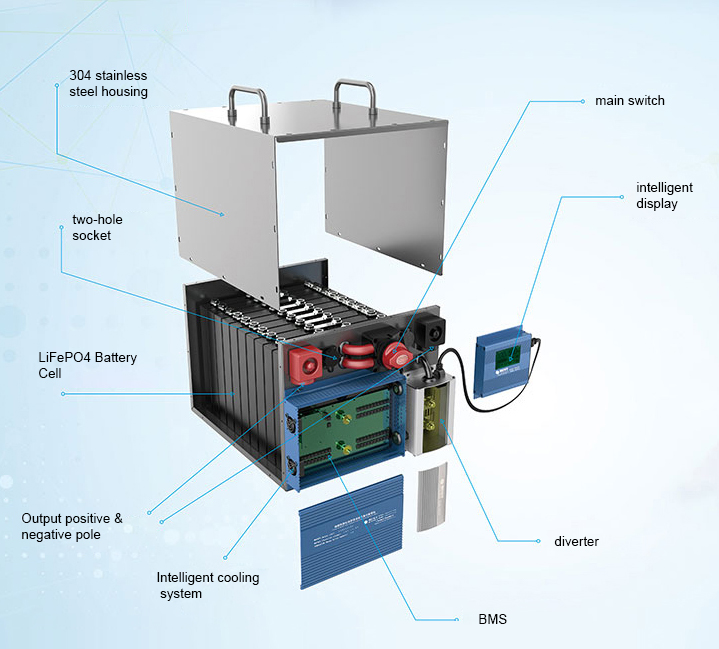 |
Welcome To Evlithium Best Store For Lithium Iron Phosphate (LiFePO4) Battery |
 |

When it comes to optimizing the performance, longevity, and efficiency of your RV, switching to Lithium Iron Phosphate (LiFePO4) batteries can be a transformative upgrade. This guide will walk you through the advantages of LiFePO4 batteries over traditional lead-acid alternatives, considerations for the upgrade process, and tips on getting the most out of your new power solution. By the end, you’ll understand why this upgrade is ideal for seasoned RV travelers and newcomers alike.

LiFePO4 batteries offer an impressive lifespan, lasting 10+ years or between 2,000–5,000 cycles on average, depending on usage conditions. Unlike lead-acid batteries, they maintain a consistent capacity even after repeated charges, ensuring that you can depend on them over the long term. For RV owners who travel frequently, this durability translates into fewer replacements and maintenance demands over time.
One of the biggest advantages of LiFePO4 batteries is their high energy efficiency. These batteries have a lower rate of energy loss, allowing them to deliver around 95% of their capacity consistently. In contrast, lead-acid batteries tend to waste more energy and can only use about 50-60% of their rated capacity. This efficiency leads to faster charging times, longer operating hours, and a more reliable power source for extended off-grid stays.
Traditional batteries can weigh down an RV and reduce its fuel efficiency. LiFePO4 batteries, however, are significantly lighter and more compact, making them an excellent choice for RVs. They typically weigh about half as much as lead-acid batteries of the same capacity, enabling you to carry more power without sacrificing valuable space or efficiency.
LiFePO4 batteries support high charging currents, which translates to quicker recharging times. With proper equipment, they can reach full capacity in just a few hours. This feature is highly beneficial for RV users who rely on solar panels or generators to recharge, as it allows for faster turnarounds between charges.
LiFePO4 batteries are highly resilient to temperature fluctuations. With proper battery management systems, they can operate efficiently in a wide range of temperatures, from freezing winter nights to hot summer days. This versatility makes them ideal for RV use, especially for travelers who journey through diverse climates.
Safety is crucial for any power source in an RV. LiFePO4 batteries are designed with enhanced safety features, including built-in protection against overheating, overcharging, and short circuits. Additionally, they are resistant to thermal runaway, which reduces the risk of fire, unlike certain other lithium-ion batteries.
Upgrading to LiFePO4 batteries in your RV involves several considerations to ensure optimal performance and safety. Follow these steps to make the switch effectively:
Begin by assessing your current and future power needs. Calculate the total watt-hours you use on an average trip, considering the appliances, lighting, and devices you want to power. This evaluation will help you determine the battery capacity needed for your setup.
LiFePO4 batteries are available in various capacities and configurations. Decide whether you need a 12V, 24V, or 48V system based on your RV’s requirements. Higher-voltage systems may offer benefits for larger RVs with extensive power demands, while 12V systems are typically sufficient for moderate use.
Ensure that your RV’s electrical system, including inverters, solar charge controllers, and other power management equipment, is compatible with LiFePO4 batteries. Some RVs may require specific charging equipment or modifications to support the unique charging profile of LiFePO4 batteries.
A Battery Management System (BMS) is essential for protecting LiFePO4 batteries from issues like overcharging, overheating, and short circuits. Modern LiFePO4 batteries typically come with a built-in BMS, but if they don’t, you’ll need to install one separately to safeguard your battery’s performance and lifespan.
Upgrade your charging system, if necessary, to support the fast-charging capabilities of LiFePO4 batteries. Consider investing in solar panels, a high-quality charge controller, or a compatible inverter-charger to optimize your setup for LiFePO4’s efficiency and quick charging properties.
Once installed, test your new LiFePO4 system thoroughly. Monitor its performance under various loads, and ensure all equipment and connections function smoothly. Regular maintenance and testing will help you catch potential issues early and maintain peak performance over time.
While LiFePO4 batteries have a higher upfront cost compared to lead-acid batteries, their longevity and efficiency offer long-term savings. Lead-acid batteries typically require replacement every 2-5 years, whereas LiFePO4 batteries can last 10 years or more. The reduction in replacement frequency, combined with savings from more efficient power usage, makes LiFePO4 a cost-effective investment over time.
Switching to LiFePO4 batteries also offers environmental advantages, including reduced toxic waste and enhanced energy independence. These batteries are more sustainable, as they contain non-toxic materials and have a lower environmental impact compared to traditional lead-acid options. For RV enthusiasts who prioritize eco-friendly choices, LiFePO4 is a responsible choice.
Although LiFePO4 batteries are resilient, maintaining proper charging habits can extend their lifespan. Avoid discharging them below 20% or charging above 100%, as these extremes can strain the cells and reduce the battery’s cycle life.
Invest in a high-quality LiFePO4-compatible charger that provides accurate voltage and current levels. This will help prevent overcharging and maintain the optimal health of your battery system. Solar charge controllers with LiFePO4 settings are ideal for RVs relying on solar power.
Inspect your batteries periodically to ensure they’re operating at peak performance. Check connections, clean any debris, and monitor the BMS for any warning signals. Regular maintenance can help you catch minor issues before they become significant problems.
Edit by paco
All Rights reserved © 2025 Evlithium Limited